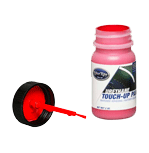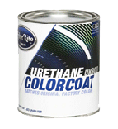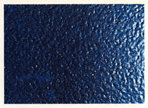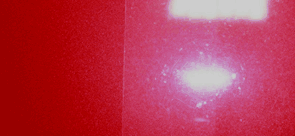Support & Tips
Welcome to our support & tips page. Here you will find information on color applications, questions and problems. If you cannot find the information you are looking for here, please contact customer support.
Which Application is Right For Me?

Small nicks and scratches:
The 1/2oz. touch-up pens are the easiest and best way to repair small nicks and scratches. If you have a stone chip, small nick, or fairly small scratch, the pen is what you need. It has a "chiseled nib" style tip that allows you to apply a very small amount or cover a larger area. The tip resembles a "magic marker" in both size and shape and is extremely easy to use. The shelf-life on the pen is excellent at 7-10 years.

Slightly larger damaged areas:
The 2 oz. touch-up bottles will repair slightly larger damaged areas. It is the traditional brush in the cap style applicator. It is best for larger scratches, as it will not achieve a very "fine" line.
Large area (Do-it-Yourself):
The 11oz. aerosol cans are great for do-it-yourselfers. You can repair a part or color-match a part at a reasonable price and achieve outstanding results. You can paint anything that can be painted professionally with an aerosol can. You can achieve near professional quality results by carefully following the instructions and having patience.

Large Area (Professional Job):
Professional Sizes (1/2 pint, pint, quart). Professional sizes are made to be applied by a trained professional. You can achieve the best results with these applications. When applied properly, these applications meet or exceed all O.E.M. standards.
How Do I Guarantee My Paint Will Be Correct?
A SPRAYOUT!!! A sprayout can save everyone a lot of time, money and frustration. It takes five minutes, but can save hours. Here's how to do it:
A sprayout is the very most important thing you can do before painting your vehicle. It helps determine how much paint you need, how to apply the paint, and gives you a feel for using the paint. You cannot expect good results without first doing a sprayout.
A sprayout is simply testing the color before you apply it to the actual repair job. If you are using a touch-up pen, just test the color on a piece of scrap you may have lying around. If the color takes a base color, test the entire application. Make sure you feel comfortable before attempting the actual repair by practicing the entire application.
If you are using any method of spraying the color, test the color on a sprayout card or on anything that you can accurately see the color. A piece of scrap metal is perfect for this if you do not have access to a spray-out card. Remember, you have to apply the clear too. It won't look the same without it.
If you are sending your parts and paint to a body shop, make sure they are willing to do a sprayout. Any body shop worth its weight will automatically perform a sprayout, but make sure they do it. Also, bring them a part of the vehicle with you so that they can obtain a proper match when the do the spraying. A body shop cannot be expected to match a color when they do not know what it looks like.
FAQs
Q: What is a spray-out?
A sprayout is the very most important thing you can do before painting your vehicle. It helps determine how much paint you need, how to apply the paint, and gives you a feel for using the paint. You cannot expect good results without first doing a sprayout.
A sprayout is simply testing the color before you apply it to the actual repair job. If you are using a touch-up pen, just test the color on a piece of scrap you may have lying around. If the color takes a base color, test the entire application. Make sure you feel comfortable before attempting the actual repair.
If you are using any method of spraying the color, test the color on a sprayout card or on anything that you can accurately see the color. A piece of scrap metal is perfect for this if you do not have access to a spray-out card.
If you are sending your parts and paint to a body shop, make sure they are willing to do a sprayout. Any body shop worth its weight will automatically perform a sprayout, but make sure they do it. Also, bring them a part of the vehicle with you so that they can obtain a proper match when they do the spraying. A body shop cannot be expected to match a color when they do not know what it looks like.
Q: Who makes your paint?
We make our own.
Q: Why do I have to take a sample to my body shop?
A body shop has to have a sample to match to because there are so many variables when painting. Spray gun pressure, type of spray gun, atmospheric conditions, and many other things can affect painting. A sample is needed to obtain the closest possible match.
Q: Why is my color a "Factory Variance Color"?
Production colors can vary from one assembly plant to another and from one application system to another. ColorRite paints have been formulated to match a factory batch standard supplied to us by the manufacturer. Occasionally, the batch standard will vary slightly from the actual production color.
This situation is most common with silvers and yellows. Silvers can vary due to the high metallic content and the way the metallic lays. This can make a silver seem lighter or darker depending on the condition. Yellows are all slightly transparent so the color can vary depending on the amount of yellow coats applied. Too few coats and the color will look greenish. You can really not apply too many yellow coats.
There are other colors that are "Factory Variance Colors" also. These, along with above mentioned examples, are a result of when a color has been upgraded or altered from the original. Unfortunately, the manufactures are not necessarily aware of this change and therefore, the color name or code is not changed. This results in two similar, but different colors with the same name and code.
The good news is that ColorRite does track the colors by year and model to try to eliminate the confusion created by variance colors. That is one reason it is so important to have the exact year, make and model when ordering.
Factory Variance Colors are also another great reason to do a sprayout.
Q: My color says it requires a base. Do I really need the base and what exactly is a "base"?
Many people confuse the "base' color for a primer. Nothing could be further from the actual facts. The base color is part of the color structure and is absolutely essential to achieve a color match. Your color will simply not match with out the base. We try to avoid using special bases if at all possible. However, if we determine that your color requires a base, you definitely need it to obtain the correct color.
Q: How do I know if my color requires a base (tri-stage)?
All tri-stage colors are indicated in the color description and also in the price.
Q: What is meant by compatibility?
ColorRite has extensive research and development time involved in producing our product line. Every color is made of a urethane basecoat/clearcoat application using the latest in paint technology. Therefore it is imperative to use only ColorRite products together to create the highest quality results possible. Use of other brand products can result in dull backs, adhesion loss, wrinkling, or poor surface conditions.
Q: My body shop has clearcoat and reducer, why do I need yours?
This question is directly related to the above compatibility question. If you use the wrong products, there is an excellent chance you will have problems. These problems may occur immediately or worse, down the road a couple months. It's not uncommon for incompatible products to look like they are working correctly, but result in crazing or cracking in a few months time.
ColorRite has specifically developed a clear coat that is high in solids to obtain the best possible finish while achieving unmatched durability. Our clear is competitively priced also. There is no substantial savings to using another brand clear when the right product is available and affordable.
The same holds true for our reducer also.
Q: What are reducer/reduction ratios?
The reducer or reduction ratio is simply the amount of reducer that is used with the amount of paint. You need reducer to "thin" the paint so it can be sprayed through a gun. The correct ratio is normally around 1:1; one part paint to one part reducer. However, some colors are thicker than others and require a little more reducer. The maximum reduction would be about 1:1 1/3; one part paint to 1 1/3 part reducer.
The opposite holds true also. Some colors such as candy colors are very thin and require less reducer. The minimum reduction ratio would be 1:3/4; one part paint to three quarters part reducer.
This is just a basic guideline. Actual reduction ratios should be determined during the sprayout.
Q: Can I sand between color coats?
NO! Do not sand between color coats. The result will be disastrous at best. The paint actually bonds with the clearcoat when it is drying. This bond is what makes the paint cure. If sanding is done between coats, the clearcoat will not bond correctly and the paintjob will be effectively ruined.
Q: What are your paints made of?
All of our products are urethane based, base-coat/clear-coat applications. Our paints have been thoroughly tested and are as good as or better than O.E.M. quality standards
Q: Is it necessary to use clear-coat?
Absolutely, clearcoat is very important for multiple reasons. First of all, it makes the paint shine. Second, the clear actually creates a chemical bond with the base color that makes it chemical and weather resistant. Without clear-coat, your paint will not shine properly or be nearly as resilient as it should be
Q: I noticed that the point of the touch up pen is removable why?
You can take the tip out and clean it with thinner. This way the pen is good to use for years.
Q: How long will my paint last?
If you are referring to the storage of the paint after use, it will last a long time. Typically, a touch-up pen lasts approximately 7 years. The aerosols and professional packaging typically will last 3-5 years if properly stored.
Q: Do I need a touch-up applicator or an aerosol can to do my job?
It all depends on what you are repairing and how large of area you are repairing. If you have a minor nick or scratch, a touch-up applicator should do the trick for you. If you are color matching a part or repairing a larger area, you will probably need an aerosol can.
Q: If I ordered paint in aerosol, will it turn out as good as a body shops paint job?
An aerosol can produce a very nice paintjob, but it simply cannot reproduce the original finish as well as a body shop can. The color will be exactly the same, but there are many other variables that can be controlled in a body shop. Dirt, spray pressure, spray-gun atomization...all these things can affect the outcome of a paint job. The only way to control these variables 100% is in a spray booth at a body shop.
Q: What do I need to do a proper paint job?
Whether using aerosols, touch up, or professional sizes we recommend primer, clear coat and the color coat. That is the only way to achieve the best results.
Touch-Up Paint Problems
The most common issue with touch-up pens or bottles is that when the topcoat or clearcoat is applied, the base color and clear/top mix togther. You definitely do not want this to happen and you'll be left to start over if it does. The most important part is make sure the area is cleaned very well with our Wax & Grease Remover to prepare the surface. At the very least, use rubbing alcohol to clean the surface.
After applying the base, let it dry for at least 2-3 hours and preferably overnight if possible. Then lightly dab the top color on. Before applying the top color or clear, make sure you already have paint on the tip of the pen. Do not pump or prime the pen on the damaged area, prime it before you go to apply it. Do not rub the pen on the area you are covering, just lightly dab it. If the color does not look exactly correct, you may have to add another light coat. To do so, just repeat the above instructions.
Paint Troubleshooting
Q: How long do I wait to apply stenciling or decals?
Allow paint to dry approximately 30-60 minutes after color coat. After stenciling or decals are applied, continue to follow the ColorRite instructions on Clearcoat application.
Q: What do I do if I have an orange peel effect?
Cause
Failure of the paint droplets to coalesce on the surface. This may be due to:

- Poor spraying technique, spray gun too far from surface, incorrect compressed air pressure, incorrect nozzle adjustment.
- Excessively thick or thin film.
- Paint incorrectly mixed, wrong viscosity, poor quality or incorrect thinner.
- Insufficient drying time between coats, cold air fanning to speed drying.
- Incorrect ambient or surface temperature, draughts.
Prevention
- Use the correct spraying technique and ensure that equipment is correctly adjusted.
- Apply paint in thin even coats.
- Ensure that the paint is correctly mixed, use only recommended thinner with the correct grade.
- Allow sufficient drying time between coats.
- Spray within the recommended temperature range and ensure proper ventilation.
Rectification
Rub out the orange peel, compound and polish. In severe cases it may be necessary to flat and repaint the surface.
Q: What do I do if my paint looks foggy/milky/hazy after clear coat?
Cause
Microscopic roughness of the surface, which may result from:

- Poor hold out of primer, or the application of topcoat over primer which is not thoroughly dry
- Poor quality or incorrect thinner, or the use of additives in the paint.
- Incorrectly prepared or poorly applied paint.
- Application over a poor substrate
- Excessively slow drying due to high humidity or low temperature.
- Solvent fumes or exhaust gases attacking the surface.
- Surface contamination by wax, grease, oil, soap or water.
- The use of strong detergents or cleaners on a newly painted surface, compounding too soon after painting or using compound which is too coarse.
Prevention
- Use an approved primer, and allow to dry thoroughly before applying the topcoat.
- Use only recommended thinner and approved additives.
- Ensure that the paint is stirred thoroughly, apply under the correct conditions using proper spraying techniques.
- Prepare the substrate thoroughly.
- Ensure that the paint dries under warm and dry conditions.
- Ensure good, draught free air over surfaces while drying.
- Wipe the undercoat with solvent and dry thoroughly before applying the topcoat.
- Avoid using strong detergents or cleaners on newly painted surfaces. Do not compound paint until thoroughly hard and always use the correct grade of compound.
Rectification
Normally the shine may be restored by rubbing down with abrasive compound and polishing. If the dulling is too severe for this to yield satisfactory results, rub down the topcoat and repaint.
Q: What do I do if my Paint/Clearcoat is peeling or bubbling?
Cause
Non uniform drying within the paint film. This may result from:

- Excessive film thickness.
- Insufficient drying time between coats, forced drying, non uniform air temperature.
- Use of wrong or poor quality thinner.
Prevention
- Apply paint in thin, even coats.
- Allow sufficient drying time between coats, ensure correct, uniform drying temperature.
- Use only recommended thinner.
Rectification
Allow the film to harden thoroughly. If the defect is slight, flat, compound and polish the affected area. In severe cases rub down to the substrate and repaint.
Q: Can I spray over my existing paint job?
Yes, sand down and remove existing clear coat with a 600 grit sandpaper. Clean the surface with a wax and grease remover and follow painting instructions. (If paint is down to bare metal or plastic, primer first)
Q: Why is it important to blend? How do I blend?
Blending is an important method to create a perfect match with no breaklines and an invisible mend.
- Do a sprayout on a scrap metal or plastic prior to applying paint to part to ensure accuracy of color variances, tip size, air pressure, paint feed, gun distance, etc.
- Follow all ColorRite prep instructions prior to paint application.
- Sand down area outside of repair to remove clearcoat with 1200-1500 grit sandpaper.
- Apply color as instructed and step it out a couple of times to blend color into surrounding areas.
- If tri-stage color apply top color to repair and surrounding areas.
- Follow drying instructions and clearcoat all repair and surrounding areas.

Q: What do I do if I get overspray on other areas?
Prevention
Mask off surrounding area that you are not painting.
Rectification
If paint is still wet wipe down with reducer. If paint has dried use a California Gold® Clay Bar Paint Saving System. If overspray is on an area that has previous clearcoat buff area to get the shine back. On painted surface with no clearcoat proceed to ColorRite clearcoat instructions.
Q: How long do I wait to mask an area before painting another area?
Follow proper ColorRite painting instructions. Allow paint to dry 30-60 minutes before masking off new area.
Q: Can I reduce my paint more than specified in the ColorRite instructions?
Yes, you may reduce paint as needed.
Q: What do I do if I have a run or sag on my paint?
A run or sag is well defined local thickening of the paint film in the form of a wavy line or shallow, rounded ridges. It is more likely to occur in sharply sloping or vertical surfaces.
Causes
- Excess thickness of application, air pressure too low, fan width too narrow, spray gun too close to the surface or moving too slowly.
- Use of poor quality or incorrect thinner.
- Incorrect viscosity of the paint.
- Air of surface temperature too low.
- Contamination of the underlying surface.
Prevention
- Use the correct spraying technique and spray gun settings.
- Use only recommended thinner.
- Ensure that the paint is mixed to the correct viscosity.
- Always spray within the recommended temperatures.
- Ensure that the surface is scrupulously clean.
Rectification
Allow the paint to harden thoroughly, rub down excess paint, flat, compound and polish. In severe cases it may be necessary to rub down and repaint the surface.
Note: Due to separation of the metal flakes, metallic paints will normally require repainting.
Q: What is the flash time of the ColorRite Paints?
Allow 5-10 minutes flash time between coats as instructed in the ColorRite instructions.
Q: What is the pot life of the ColorRite paints?
Pot life is approximately 3-4 hours.
Q: What is the shelf life of products?
Unopened and unused products approximately 1 year in a dry moderate temperature climate.
Testimonials
"I wanted to take some time and let you know that you have some great people working at Color Rite. I called in an order and received excellent service from one of your representatives. Tawny was extremely helpful and even though I asked a lot of her, she came through for me with no problem. THANKS Tawny!!!"
William
"I received the order and the color is perfect. You guys are the best."
James
"I just had to write a quick note to say how pleased I am with your company. I placed my order on your easy-to-use website, and just a short while later I received both a notification that the item had already been shipped and an invoice for my records. The product came in quickly and was an exact color match. Thank you for a great online shopping experience~ I will definitely recommend your company to others!"
Andrea
"Bravo! You folks have the fastest shipping, the best internet response, and a great product. The touchup paint I received is a perfect match. You even charged me actual shipping cost rather than the fixed rate. I could not have asked for more. I just went out and posted a recommendation for your products and service on Suzukihaybusa.org. Maybe you'll get some business from it. Way to go."
Russ
"I was very surprise at your excellent service and kindness. It is really refreshing to know that there are still great companies out there; ColorRite is a prime example. It is my duty now to share with friends and co workers about this experience and I am sure they will use your services in the future. Thanks again."
Jeason
